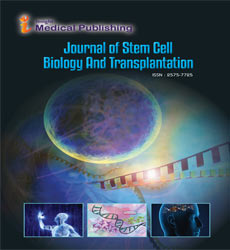ISSN : 2575-7725
Journal of Stem Cell Biology and Transplantation
Analisis de cocultivo de fibroblastos y celulas troncales mesenquimales sobre un andamio biocompatible
Abstract
Skin wound healing is a dynamic and complex process which evolves at different phases and is highly regulated by molecular and cellular pathways. Epidermal cell populations like fibroblasts, for example, interact with cytokines and growth factors delivered to the injured area letting the activation of signaling cascades to remodel the extracellular matrix (ECM). Fibroblast is capable of degrading and producing distinct proteins in order to provide an environment which allows migration, proliferation and angiogenesis. When the normal wound healing progression through the different phases is disturbed, the wound may become chronic. Frequently non-healing wounds remain in a transition state between inflammation and proliferation phases while remodeling phases become impaired. Scarring is the final point of typical mammals healing and represents a fibrinogenous tissue rich in collagen. Even though scaring can result in useless and anti-aesthetic tissue. In both cases, chronic wounds and scaring tissues can generate significant health issues. Engineering tissue combines alternative materials with a particular chemical, physical and biological characteristics to create scaffolds that support cell growth which promotes repair and regeneration processes. An ideal scaffold should possess excellent biocompatibility, biodegradability, and suitable mechanical properties. Somatic stem cells represent an excellent resource for regenerative medicine and engineering tissue development. This is due to their remarkable capacity for selfrenewal, as well as their ability to differentiate along multiple cell lineages maintaining the capacity of adult tissues to be replenished as a part of the normal process of homeostasis and repair in response to injury. The multipotency of mesenchymal stem cells have shown effectiveness in enhancing the regeneration and repair of different tissues types by upregulating multiple growth factors and directly differentiating into particular cell types contributing to healing. Adipose-derived stem cells (ADSC) are a particularly attractive type of adult stem cell because this tissue is routinely discarded from liposuction procedures which are also relatively non-invasive and low risk. Furthermore, ADSC are easily harvested from the stromal vascular fraction obtaining higher yields compared to bone marrow. Pork skin has been used as a protective barrier while keeping hydration which helps prevent infections. Recently Sánchez S. and his team proposed using pork skin that has been radio-sterilized like a scaffold to support ADMSC due to its capacity to maintain their viability and to promote proliferation. Leading to the hypothesis that the high similarity between pork and human ECM composition (mainly by collagen type I) plays an important role, although there is not an official scientific report on it. The objective of this project was to generate an ADMSC and fibroblast co-culture, using a scaffold of radio-sterilized pork skin to evaluate the release of growth factor and the ECM-related protein expression. The results suggested PPR is regulating collagen I and III mRNA expression, modifying the proportion between them (against the control group) while stimulating VEGF, EGF and bFGF secretion.
Open Access Journals
- Aquaculture & Veterinary Science
- Chemistry & Chemical Sciences
- Clinical Sciences
- Engineering
- General Science
- Genetics & Molecular Biology
- Health Care & Nursing
- Immunology & Microbiology
- Materials Science
- Mathematics & Physics
- Medical Sciences
- Neurology & Psychiatry
- Oncology & Cancer Science
- Pharmaceutical Sciences
